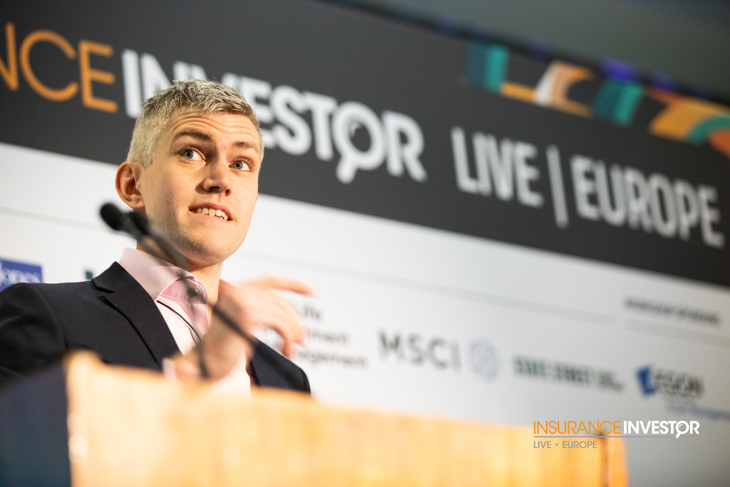
Nearshoring, reshoring, and the trend of deglobalisation may be buzzwords of 2023, but they’re not backed up by the data, said James Pomeroy, Global Economist, HSBC.
At Clear Path Analysis’s Insurance Investor Live Europe event, on today in London, senior insurance figures gathered to discuss the biggest issues in investment and asset management for the industry.
Pomeroy’s presentation looked at the long-term trends and focused on understanding the challenges of the market in 2023.
"Where is this recession? New data shows that the US
is definitely not in recession."
“We’ve gone through a year where everything has been remarkably resilient. We said last year that we’d definitely be in a recession. But where is this recession? New data out shows that the US is definitely not in recession,” he said.
Pomeroy said that 2022 had been a remarkably resilient year, despite awful sentiment. “Consumers just keep spending,” he said. However, the forward-looking data appeared “a bit worse” with manufacturing, and consumer behaviour “cooling”, which Pomeroy said was due to pent-up spending appetite from the lockdowns ending. This, he said, meant economies could take a hit. “A slowdown is coming but the real question is how bad will it be?”
"Housing markets give reason to worry as prices drop due
to weaker affordability."
He said that one area likely to be at the forefront of this slowdown was the housing market. “Housing markets give reason to worry as prices drop due to weaker affordability.” UK, New Zealand, and Canada are all seeing price drops, Pomeroy said, with other markets in the US and western Europe also seeing some worrying patterns when measured by certain indicators.
One of the main statistics that showed this trend was the huge collapse in housing transactions – for example, the lack of people putting their houses on the market because prices were flat and mortgage rates were rising.
Pomeroy said the disinflation trend was also centred around China. He discussed the huge hits to household incomes but said that there was some upside risk – which was also coming from China.
China’s housing market has also seen a collapse in transactions, just like in the UK, but Beijing has quickly tried to reverse this and try to engineer a market pickup.
"Households with a tonne of savings from the pandemic will go out
and spend money the moment they can.”
China’s “reopening” also has the “potential to be massive”, he added with Chinese consumers also having a pent up appetite for spending. Currently, this consumer spending is 30% down and could easily jump back up entirely, he added.
“As we saw in [countries no longer in lockdown] households with a tonne of savings from the pandemic will go out and spend money the moment they can.”
Key for investors, Pomeroy predicted a robust bounce in the China market later this year – an indicator of China’s changing society. In previous times, the bounce back would have been overwhelmingly driven by infrastructure projects and government spending to drive growth, but this time is expected to come through consumerism. Chinese consumers going on vacations and spending on services could be key for not just the domestic economy but also the wider Asian market.
However, he warned, this won’t last forever and could see trends change in late 2023 as this catch-up appetite from lockdown wanes, which could be the catalyst for a slowdown. “Part of the global economy are booming because people haven’t done anything for two years and are desperate to go out and spend money,” he said.
Inflation is peaking. “In Asia, inflation is where it was because China hasn’t been hit,” Pomeroy said.
Separately, data in the US reveals that goods are decreasing in price as consumer spending wanes, but that services are driving much of the growth.
This, coupled with China’s appetite, could lead to a volatile and mixed market toward the end of 2023 and into the next year.
“Inflation is almost certainly peaking in most of the world,” he said. “Some of that is commodities – oil gas, food, and metals prices are down since the summer, which feeds into inflation affects headline and core figures.”
"The surge in shipping costs we saw in 2021 is responsible for a
considerable amount of global inflation since."
Pomeroy said the biggest story is about changes to supply chains this year. “The surge in shipping costs we saw in 2021 is responsible for a considerable amount of global inflation since - what it did to supply - had to over order which was a huge challenge for businesses.”
He listed the Port of Los Angeles’s policy of charging $100/day for empty shipping containers left on the docks as the single most important policy change that happened throughout the pandemic to halt inflation.
“Cutting back on goods spending in favour of services nearly came to a halt, which has almost taken away all the supply demand imbalance in shipping,” he said, which meant that businesses had huge inventory just as people are not willing to buy, which means price cuts to clear out inventory.
“Q4 2022 was the second most deflationary quarter in the US ever but people ignore because they look at year to year numbers,” Pomeroy said in conclusion – with a warning to dive deeper into the data and check biases and media narrative against the facts that were emerging.